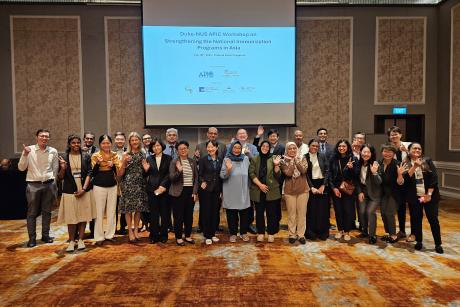
Community health workers carry a child bitten by a snake for treatment at a health center in the Brazilian Amazon region.
Published January 4, 2024, last updated on December 3, 2024 under Partnerships
Making antivenom more widely available across a network of hospitals and community health centers in Brazil’s Amazon region would significantly reduce death and disability from venomous snakebites, a new study has found.
The Brazilian state of Amazonas has one of the world’s highest rates of snakebite, with between 45 and 235 venomous snakebites per 100,000 people annually. Timely treatment with antivenom is highly effective against most bites. In Brazil, however, antivenom is generally available only in larger, urban hospitals, and many people bitten by venomous snakes in remote parts of the state suffer serious complications or even die before they can reach treatment.
The new study, conducted by scientists and physicians from Duke University and two Brazilian institutions, evaluated the cost-effectiveness of making antivenom available across more hospitals and community health centers in the region. The results, published in the January 2024 issue of The Lancet Regional Health Americas, show such a step would be a worthy investment.
“We believe that ours is the first study to evaluate the health and economic benefits of increasing the accessibility of snake antivenom in Latin America,” says João Ricardo Nickenig Vissoci, Ph.D., an assistant professor with the Duke Global Health institute (DGHI) and the study’s lead author.
The researchers evaluated three strategies for expanding access to snake antivenom in Amazonas. One model made antivenom available in 95 percent of the state’s hospitals, while a second model tested availability in 95 percent of community health centers, which are more widely distributed in rural areas. The third model expanded access to both hospitals and community health centers.
All three models produced net economic benefits worth millions of U.S. dollars and prevented deaths and disabilities, as measured by disability-adjusted life-years (DALYs), which count the number of years of life that are impacted by or lost due to disease or injury. According to the research, expanding access to both hospitals and community health centers would produce the largest benefits, averting up to 3,922 DALYs while yielding economic benefits of up to US$8.98 million. The cost of expanding access was around $328 for every DALY averted.
Despite Brazil’s robust production of antivenom drugs, the findings show that lack of access to antivenom can have a significant impact on the regions where most snakebites occur. “Policies that promote access to snake antivenom should be a priority to countries with an elevated snakebite envenoming burden,” says Vissoci, who is chief of the Duke Department of Emergency Medicine’s Division of Translational Health Sciences.
The next step for the researchers is to begin trials making antivenom available at community health centers in Amazonas. Community care providers can be trained to administer antivenom safely and effectively, the researchers say.
The new research is consistent with the recommendations of a World Health Organization working group on snakebite envenoming, which emphasized that sustainable strategies for dealing with snakebites depend on more than therapeutics, notes Charles J. Gerardo, M.D., interim chair of Duke’s Department of Emergency Medicine and joint senior author of the study. “It depends on the decentralized distribution of treatment, as well as on the infrastructure and knowledge to deliver it.”
The study’s cost-benefit analysis was led by Osondu Ogbuoji, MBBS, ScD, deputy director of the Center for Policy Impact in Global Health at DGHI, and Wuelton Monteiro, Ph.D., from the Fundação de Medicina Tropical Doutor Heitor Vieira Dourado (FMT-HVD) in Manaus, Brazil. Scientists from Brazil’s Butantan Institute also contributed to the research.
The research was funded by the NIH Fogarty International Center; Conselho Nacional de Desenvolvimento Científico e Tecnológico; and Fundação de Amparo à Pesquisa do Estado do Amazonas.


